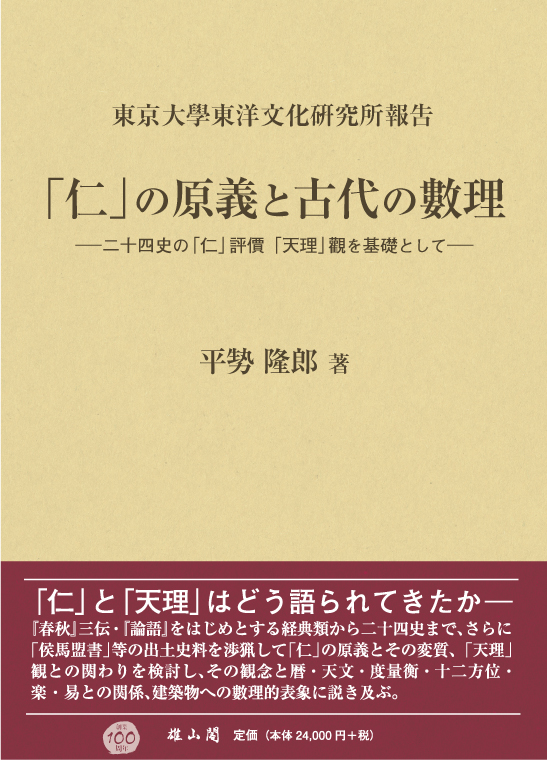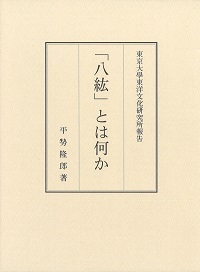
Title
'Jin' no Gengi to Kodai no Suri (Ren’s Origin and Ancient Mathematical Principles - On the Basis of the 24 Authentic histories’ two Ren Sphere Arguments And Tianli Concept)
Size
556 pages, B5 format, hardcover, slipcase
Language
Japanese
Released
December 10, 2016
ISBN
9784639024538
Published by
Yuzankaku. inc
Book Info
See Book Availability at Library
Ren 仁 is a key concept among Confucian scholars. They understand it as “loving kindness,” “charity,” “virtue,” “moral virtue,” “perfect virtue,” and so on. European scholars understand it to mean “benevolence.” Hence, when they read Confucian classics, they understand it as such. However, during two thousand years till modern times, this key concept held a different meaning. This book clarifies this discovery, retroact to Pre-Qin times, and inquire into the origin of the concept of Ren.
To understand the concept of Ren, we must investigate Tianli 天理, or, heaven’s reason. From my investigation, I realized that the Chinese Emperor’s special virtue Ren on 24 Authentic histories, spread to all Under Heaven 天下 through his bureaucratic system. Heaven’s reason was its background. On its under unit of prison, a bureaucrat had to make a choice, using rigid law, or making allowances for people in the name of the Emperor. Ren’s general derivative meaning (bureaucrat’s Ren) arose from this allowance.
The concept of Tianli is divided into two. Until the Jiutangshu 舊唐書, it could be understood on the basis of a plane and solid geometrical figure, especially a regular octagon. This sort of idea was used on architecture, Buddhist temple’s sphere etc. Confucian classics Yijing 易經’s Bagua 八卦 eight directions formed its background. After the Xintangshu 新唐書, this background faded out.
In the Warring States Period, they used a prototype of its background. However, present-day scholars have not recognized this prototype yet. In the Spring and Autumn Period and until the middle of the Warring States Period, the prototype of the background had not appeared. Present scholars have not recognized these situations, too.
After the middle of the Warring States Period, although they had received the above-mentioned prototype, the concept of “heaven’s reason” had not appeared. However, they had already argued about the Bagua八卦 eight directions. They recognized heaven, the underground, and the earth by the Pythagorean method of making musical notes, with cosmological observation.
Until the middle of the Warring States Period, they only knew the Pythagorean way of making musical notes. And after the middle time of the Spring and Autumn period, they started a prototype of the bureaucratic system. And after the latter time of the Spring and Autumn period, they started a prototype of the Ren Concept.
Although there were small city countries, a prototype of the Xian bureaucratic system had already been established, under the small city country and the prototype of the bureaucratic Xian, there remained a tribal order. However, the strong and main city country’s authority spread to both. They used their international religious places, for example, as relay stations between each country and the king’s city. Although they made much of the king’s authority, they used the Japanese Omoiyari-like mind for each country’s religious places. Ren was this sort of knowledge with a Omoiyari mind.
From the middle of the Warring States Period, small city countries and prototype xians were changed to be bureaucratic Xians. Ren was changed to become a King’s special virtue to xian cities by the bureaucratic system. In the time of the 24 Authentic histories, Ren was changed to become the Emperor’s special virtue.
As the result of the above-mentioned changes, modern scholars’ understanding was a little similar to that of the original situation during the Spring and Autumn Period and the Warring States Period. Hence, they were unable to recognize the concept of Ren of the Emperor, in the 24 Authentic history times. Neither could they understand it in the Warring States Period. It never occurred to them that the above-mentioned origin of Ren existed in the latter time of the Spring and Autumn Period (until the middle of the Warring States Period), that is, during the time of Confucius.
This book’s conclusion is derived from the 24 Authentic histories and traditional Confucian Classics. Mathematical reason is explained by the Pythagorean way of making musical notes, plane and solid geometrical figures (just like Classics of the Greeks and Romans), and so on.
(Written by HIRASE Takao, Professor, Institute for Advanced Studies on Asia / 2019)



 Find a book
Find a book


